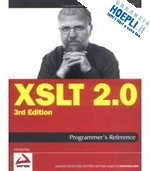
-
DISPONIBILITÀ IMMEDIATA
{{/disponibilitaBox}}
-
{{speseGratisLibroBox}}
{{/noEbook}}
{{^noEbook}}
-
Libro
-
- Genere: Libro
- Lingua: Inglese
- Editore: John Wiley & Sons
- Pubblicazione: 08/2004
- Edizione: 3rd Edition
XSLT 2.0 Programmer's Reference
kay michael
34,80 €
{{{disponibilita}}}
TRAMA
The book is the authoritative reference guide to the language. Without using the formal and inaccessible language of the W3C specifications, it tells the reader exactly what every construct in the language does, and how it is intended to be used. It is a reference rather than a tutorial; it is designed for the professional programmer who is using the language every day. It is the book that people quote when they claim that a particular product is giving the wrong answer, and the book that implementers of the language turn to when they want clarification of the specifications. At the same time, the book is readable. Reviews of the previous editions show that readers appreciate the background material on the design thinking behind the language, the essay on functional programming, the occasional dry wit, the gentle criticism of the language specification when appropriate, and the fact that the examples stray into a diverse range of interesting application areas.NOTE EDITORE
When XML debuted in 1998, it was quickly embraced as both a practical tool and a strategic technology. XSLT and XPath soon became the preferred high–level languages for manipulating XML content. Now the editor of the XSLT 2.0 specification has written the ultimate reference manual for XSLT 2.0. You’ll gain a complete understanding of the concepts underlying XSLT, what’s new in version 2.0, the structure of XSLT stylesheets, their relationship to XML schemas, and more. You will see how the language provides extensibility, and how to use it to create real XSLT applications. Finally, you will learn to use XSLT as a functional programming language to tackle complex computational problems. What you will learn from this book What’s new in XSLT since the previous edition of this bestselling book Where XSLT fits into the XML family What every construct in the language does, and how to use each one How XSLT transforms XML to handle data conversions and data publishing How to use XSLT elements, patterns, and functions Development methods for specific stylesheets How to apply XSLT design patterns to produce selected results Who this book is for This book is for professional XML and XSLT programmers and programmers experienced in XML, HTML, and Web architecture who want to learn XSLT. Wrox Programmer’s References are designed to give the experienced developer straight facts on a new technology, without hype or unnecessary explanations. They deliver hard information with plenty of practical examples to help you apply new tools to your development projects today.SOMMARIO
Acknowledgments. Introduction. List of Examples. Chapter 1: XSLT in Context. Chapter 2: The XSLT Processing Model. Chapter 3: Stylesheet Structure. Chapter 4: Stylesheets and Schemas. Chapter 5: XSLT Elements. Chapter 6: Patterns. Chapter 7: XSLT Functions. Chapter 8: Extensibility. Chapter 9: Stylesheet Design Patterns. Chapter 10: Case Study: XMLSpec. Chapter 11: Case Study: A Family Tree. Chapter 12: Case Study: Knight s Tour. Appendix A: XPath 2.0 Syntax Summary. Appendix B: XPath Function Library. Appendix C: Microsoft XSLT Processors. Appendix D: JAXP: The Java API for Transformation. Appendix E: Saxon. Appendix F: Backwards Compatibility. Glossary. Index.AUTORE
Michael Kay has been working in the XML field since 1997; he became a member of the XSLWorking Group soon after the publication of XSLT 1.0, and took over as editor of the XSLT 2.0 specification in early 2001. He is also a member of the XQueryWorking Group. He is well known not only through previous editions of this book, but also as the developer of the open–source Saxon product, a pioneering implementation of XSLT 2.0, XPath 2.0, and XQuery 1.0. The author has recently formed his own company, Saxonica Limited, to provide commercial software and services building on the success of the Saxon technology. Previously he spent three years with Software AG, working with the developers of the Tamino XML server, a leading XQuery implementation. His background is in database technology: after leaving the University of Cambridge with a Ph.D., he worked for many years with the (then) computer manufacturer ICL, developing network, relational, and object–oriented database software products as well as a text search engine, and held the position of ICL Fellow.ALTRE INFORMAZIONI
- Condizione: Nuovo
- ISBN: 9780764569098
- Collana: Wrox - Programmer to Programmer
- Dimensioni: 233 x 48.3 x 188 mm Ø 1338 gr
- Formato: Brossura
- Pagine Arabe: 960
